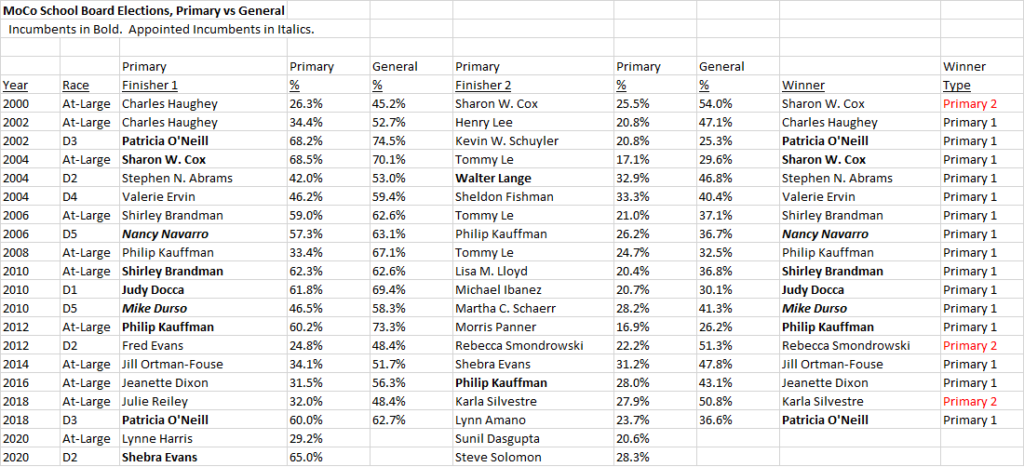By Adam Pagnucco.
This year saw one of the most contentious school board primaries in recent county history. With incumbent at-large school board member Jeanette Dixon announcing her retirement, a 13-member field filled social media and press accounts in their quest to succeed her. Perhaps the foremost issue was MCPS’s boundary study, which was both supported and opposed by numerous candidates. The primary’s survivors are former PTA president and MCPS teacher Lynne Harris and Universities at Shady Grove professor Sunil Dasgupta, both boundary study supporters. Now they are facing off in a general election that will reach its conclusion next week.
Who is going to win, Harris or Dasgupta?
Here is what we know. Harris has been endorsed by the Washington Post and is supported by a large number of PTA activists, including her campaign manager, Laura Stewart. Dasgupta has been endorsed by MCEA, wielder of the mighty Apple Ballot, as well as SEIU Local 500, Casa in Action and Progressive Maryland. His campaign manager is MCPS teacher Chris Wilhelm, who ran a strong campaign for county council at-large two years ago. (Wilhelm and Stewart, besides being the campaign managers, are both well-qualified to be school board candidates themselves!) Dasgupta has outraised Harris but neither has the money to effectively reach a general electorate which will probably have a half million voters. The campaign seems devoid of the rancor that characterized the primary although some teachers were upset with Harris’s remarks criticizing MCEA over the issue of school reopening.
Both candidates have written guest blogs on Seventh State. Dasgupta wrote Distance Learning May be Plan C, but it is the Best Option Right Now on July 17 and Changing the Reopening Timeline: a Recipe for Confusion and Anxiety on September 28. Harris wrote Reopening Plans – MCPS is Behind on October 25. All three posts attracted significant numbers of readers.
At first glance, both Harris and Dasgupta seem to have plausible chances to win. But this is Seventh State, so let’s not stop there. On to the spreadsheet!
Let’s look back at the last twenty years of school board races. The table below examines the frequency with which candidates who finish first in a primary go on to win the general election. (Races in which there are two or fewer candidates don’t have primaries but rather advance directly to a general election.) Incumbents appear in bold, with appointed incumbents also appearing in italics.

In the last 18 school board races with both primaries and generals, the top finisher in the primary went on to win the general 15 times. That’s good news for Harris, who finished first in the primary this year. But let’s not declare the race over yet. The three cases in which the top primary finisher did not win have four things in common.
The election had an open seat.
That’s the case this year as Harris and Dasgupta are vying to replace a retiring incumbent.
The top finisher in the primary received a low percentage of the total vote.
In the 2000 at-large race, Charles Haughey finished first in the primary with 26% of the vote. In the 2012 district 2 race, Fred Evans finished first in the primary with 25% of the vote. In the 2018 at-large race, Julie Reiley finished first in the primary with 32% of the vote. All three would go on to lose the general. Harris’s percentage in the primary, 29%, is in the same ballpark as these other candidates.
The second finisher in the primary had either the Post or the Apple Ballot.
In the 2000 at-large race, Sharon Cox was endorsed by the Post. In the 2012 district 2 race, Rebecca Smondrowski was endorsed by the Post. In the 2018 at-large race, Karla Silvestre had the Apple Ballot. All three came back from second-place finishes in the primary to win the general. As noted above, Dasgupta has the Apple.
The difference between the top and second finishers in the primary was five points or less.
In 2000, Cox trailed Haughey by 1.8 points in the primary. In 2012, Smondrowski trailed Evans by 2.6 points. In 2018, Silvestre trailed Reiley by 4.1 points. All three came back to win the general. Harris led Dasgupta in this year’s primary by 8.6 points. That’s a bigger margin than the other three races discussed here.
And so, Dasgupta meets three of the four conditions under which second place primary finishers won school board general elections over the last 20 years. Only the margin by which Harris finished first in the primary augurs against him.
So what do you think, readers? Does Harris have the edge because she won the primary by almost 9 points? Or can Dasgupta come back to win?
